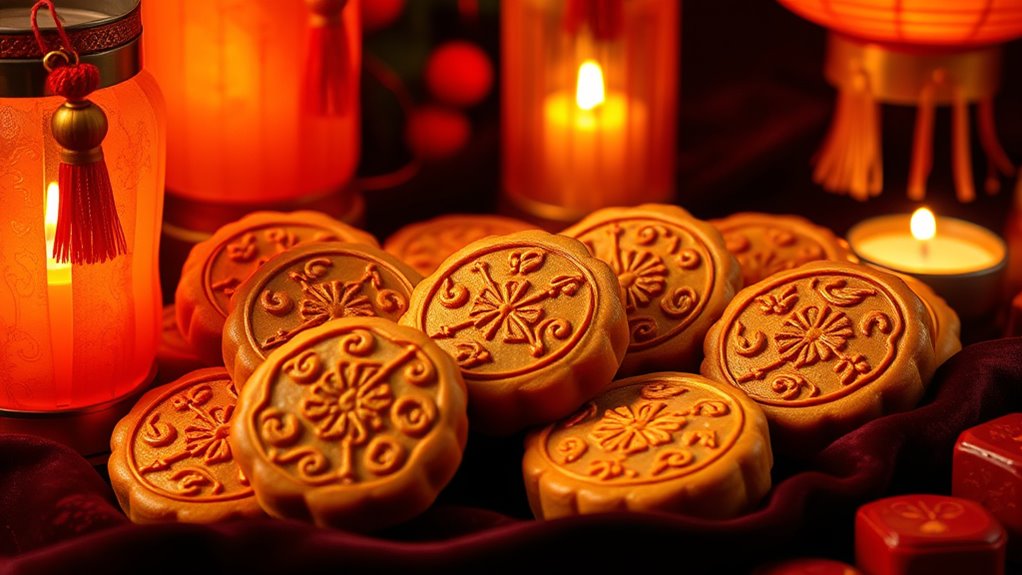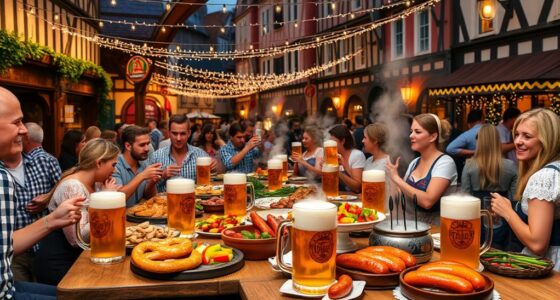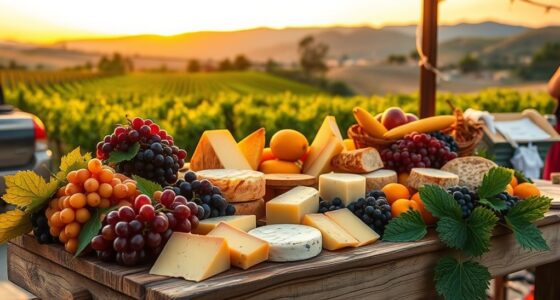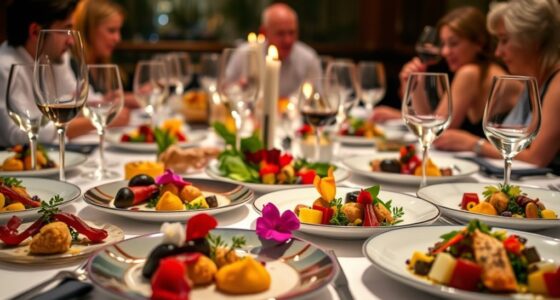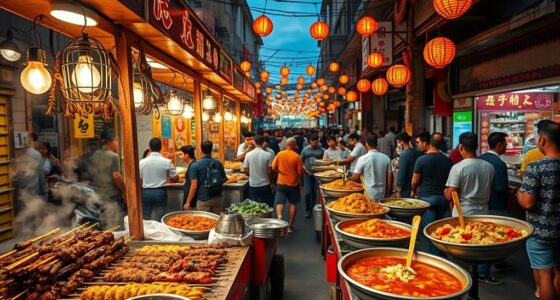During the Mid-Autumn Festival, you can enjoy mooncakes with a variety of flavors like lotus seed, red bean, mango, durian, and even innovative options like ice cream and salted egg yolk. Lanterns often feature traditional symbols like the moon, flowers, or animals, crafted with intricate techniques. These treats and decorations celebrate unity, cultural heritage, and creativity. If you want to discover more about their rich history and modern twists, there’s plenty to explore below.
Key Takeaways
- Traditional mooncake fillings include red bean, lotus seed paste, salted egg yolk, and mixed nuts symbolizing prosperity and unity.
- Modern mooncake flavors expand to include durian, mango, chocolate, and low-sugar options catering to diverse tastes.
- Lantern designs often feature motifs like the moon, animals, and flowers, reflecting cultural symbols and stories.
- Innovative lantern styles incorporate LED lights, multimedia, and artist collaborations while preserving traditional craftsmanship.
- Festival treats and decorations emphasize themes of harmony, abundance, and cultural heritage through colors, motifs, and flavors.
The Origins and Evolution of Mid-Autumn Celebrations
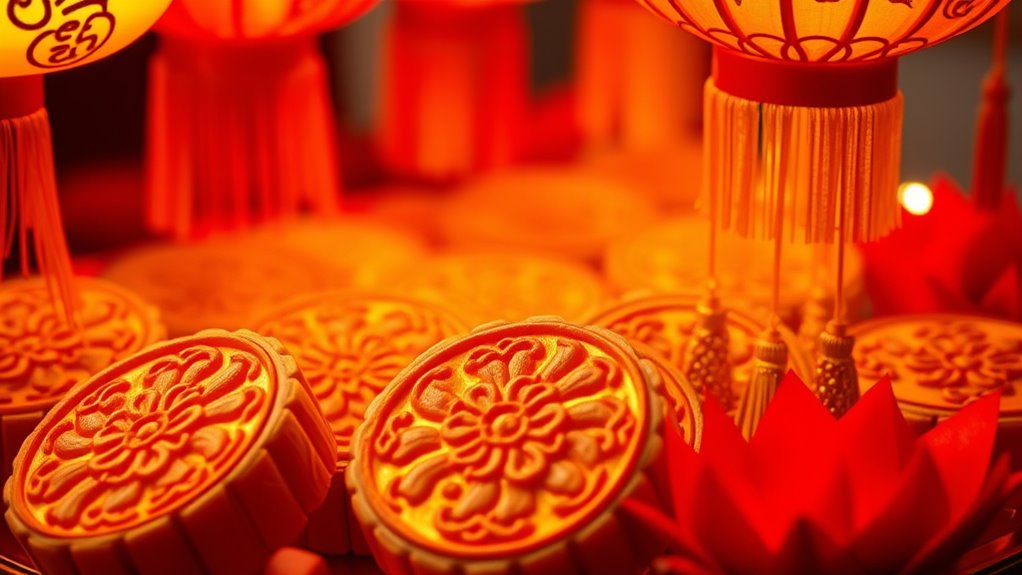
Have you ever wondered how the Mid-Autumn Festival began and how it has changed over thousands of years? It all started in ancient Chinese dynasties, over 2,000 years ago, with moon worship tied to the lunar calendar. Early emperors celebrated the harvest moon during the Zhou dynasty, offering thanks and seeking blessings for good crops. The Shang Dynasty also linked lunar worship with harvest rites, laying a cultural foundation. Over time, the festival incorporated festival music, storytelling, and family gatherings. During the Tang and Song Dynasties, myths like Chang’e became central, and celebrations grew more elaborate, with moon-viewing parties and poetry. By the Ming and Qing eras, the festival rivaled Chinese New Year, evolving into a major social event that celebrated cultural identity and community. Throughout history, the festival has also served as a time for secret messaging and political communication, especially during periods of unrest. Recognizing the importance of cultural traditions, the festival’s practices have continued to evolve while maintaining their symbolic significance.
Symbolism Behind Mooncakes Through the Ages
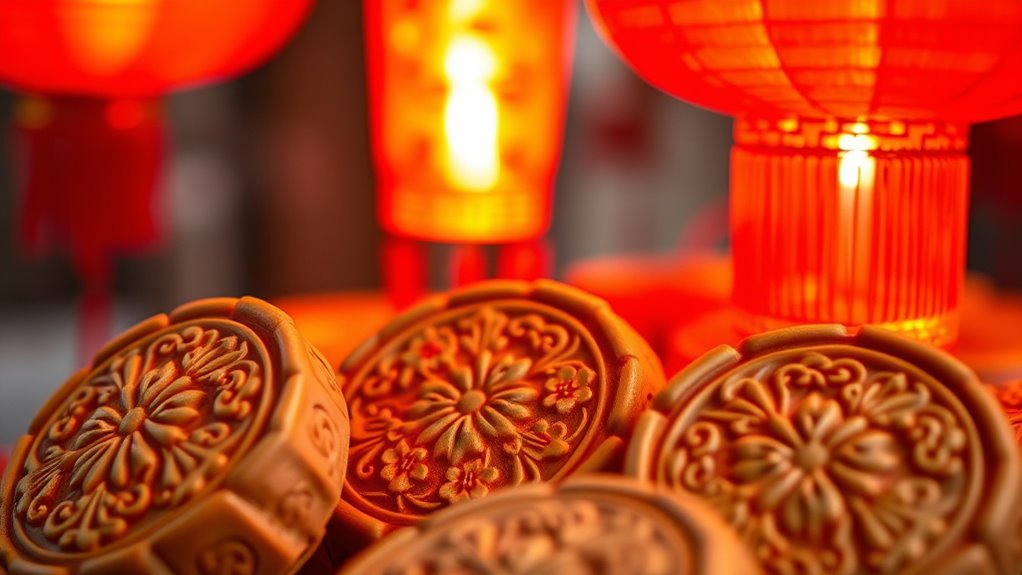
| Aspect | Symbolic Meaning | Connection to Lunar Mythology |
|---|---|---|
| Full Moon Shape | Completeness, family reunion | Chang’e’s story of immortality |
| Sharing Customs | Social cohesion, harmony | Offerings to the moon |
| Traditional Fillings | Prosperity, natural cycles | Lunar influence on harvest |
| Political Role | Resistance, hope | Symbols of unity |
| Cultural Bonding | Intergenerational, collective pride | Cultural continuity |
| Mooncakes also serve as a reminder of the ancient rituals that continue to bring families together during this festival. These traditions help preserve cultural identity across generations.
Traditional Foods and Their Cultural Significance
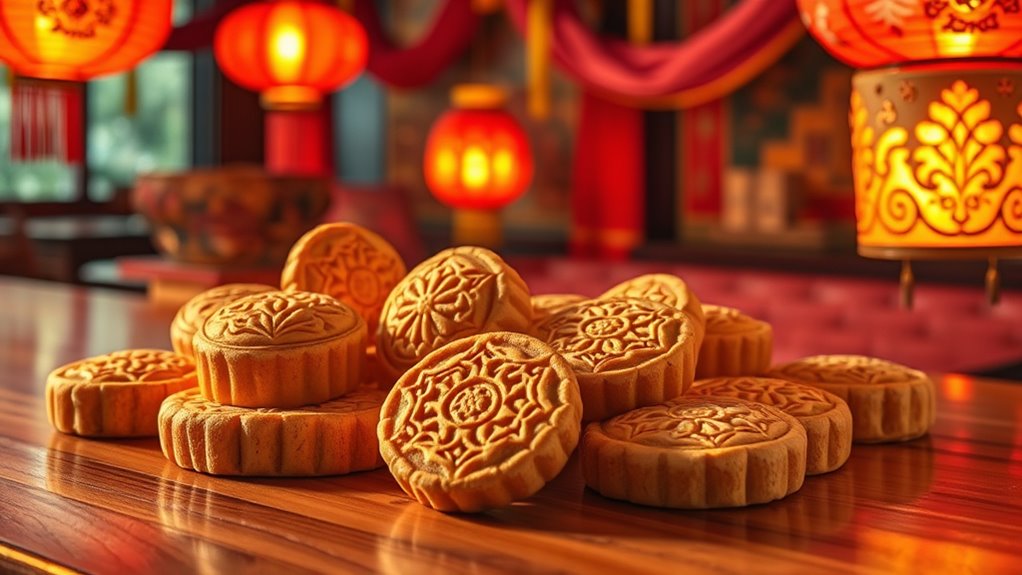
During the Mid-Autumn Festival, traditional foods carry deep symbolic meanings that reflect wishes for good luck, family unity, and prosperity. You’ll notice how dishes like lotus root and rice balls embody themes of harmony and completeness, while seasonal delicacies like hairy crab highlight the harvest’s bounty. These foods not only satisfy appetites but also reinforce cultural values and connect generations through shared culinary traditions. Mooncakes—the essential festive treat—symbolize family reunion with their round shape resembling the full moon, emphasizing unity and togetherness. Additionally, traditional foods like lotus root also align with predictive analytics, as they help anticipate the needs and preferences of families celebrating the festival.
Symbolic Food Offerings
Symbolic foods play an essential role in Mid-Autumn Festival celebrations, embodying wishes for unity, prosperity, and good fortune. You’ll notice mooncakes with diverse fillings like red bean or lotus seed paste, symbolizing harmony and abundance. The round shape of mooncakes and lantern designs both represent completeness and family reunion. When sharing mooncakes, you express goodwill and strengthen bonds. Traditional offerings also include items like pomelo, taro, and duck, each carrying auspicious meanings related to protection, fertility, and fidelity. These foods, often presented on altars or shared among loved ones, serve as tangible expressions of gratitude and hopes for blessings. Celebrating the seasonal harvest, these symbolic offerings deepen the festival’s spiritual significance, reminding you of the importance of unity and prosperity. Additionally, understanding the personality traits associated with festival traditions can enhance your cultural experience and personal reflections during this special time.
Cultural Food Traditions
Have you ever wondered how traditional foods shape the cultural significance of the Mid-Autumn Festival? Mooncakes, with their diverse fillings like lotus seed paste, red bean, salted egg yolk, and mixed nuts, reflect regional tastes and histories. Their round shape symbolizes family reunion and completeness. Lantern patterns often depict symbols like the moon, flowers, or animals, reinforcing themes of harmony and prosperity. In different regions, mooncakes vary in crust and filling, emphasizing local customs—Cantonese mooncakes are thin and rich, while Suzhou styles are flaky and savory or sweet. Beyond China, Vietnamese mooncakes also celebrate family ties with unique flavors. These foods and their intricate lantern patterns preserve cultural stories, highlight regional identities, and deepen the festival’s meaning of unity and gratitude. Mooncake — The Must-Eat Food is traditionally homemade, but now mainly manufactured in bulk for seasonal sale, ensuring that everyone can enjoy this symbol of unity. Additionally, the cultural significance of food during the festival helps strengthen community bonds and shared traditions.
The Art and Meaning of Lantern Craftsmanship
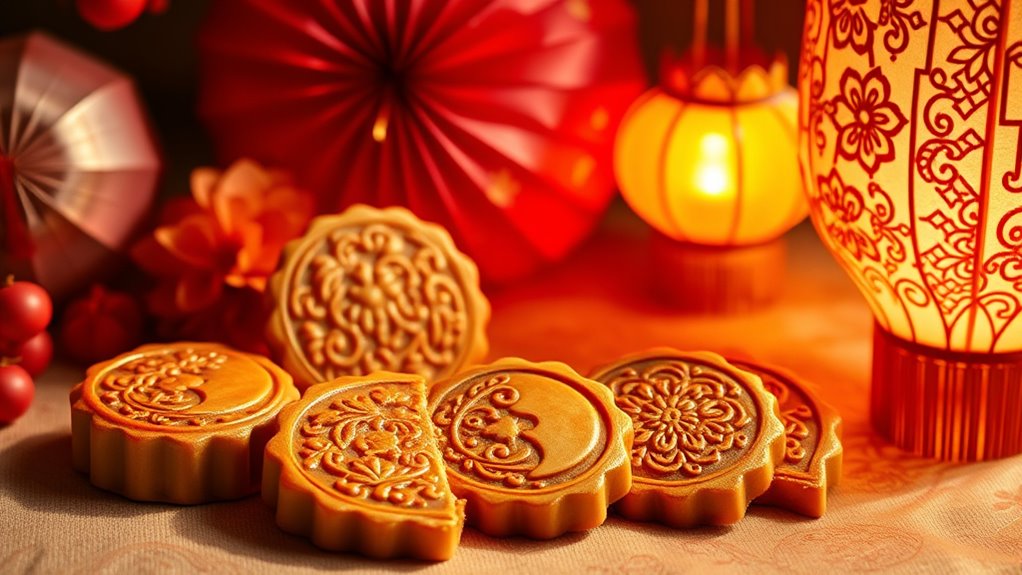
You can see how traditional lantern designs reflect cultural stories and beliefs, from animal shapes like rabbits to geometric forms. Each craft detail carries symbolic meaning, representing themes like luck, unity, and legends. By understanding these motifs, you’ll appreciate how lantern craftsmanship connects art with cultural identity during the festival. Additionally, the intricate craftsmanship involved in making these lanterns often employs traditional techniques, highlighting the skill and heritage passed down through generations.
Traditional Lantern Designs
What makes traditional lantern designs so mesmerizing is how they blend craftsmanship, symbolism, and artistry into lightweight, portable creations. Lantern craftsmanship involves using thin paper stretched over bamboo or wire frames, making each piece both delicate and durable. Shapes like round, animal, fruit, and lotus symbolize concepts such as harmony, prosperity, and purity. Artists craft intricate patterns through folding, cutting, and assembling layered paper, highlighting their skill and attention to detail. Modern innovations include LED lighting and multimedia features, but the core designs preserve cultural symbolism. These lanterns are crafted to be easily carried or hung during night processions, balancing stability with portability. Every detail reflects a deep cultural meaning, making each lantern a small masterpiece of tradition and artistry. Additionally, zodiac symbolism is often incorporated into lantern designs to convey auspicious messages and cultural stories.
Cultural Symbolism in Craft
Traditional lantern designs are more than decorative objects; they are rich symbols woven into cultural stories and beliefs. Lantern symbolism reflects hopes for prosperity, luck, and family reunion, especially during the Mid-Autumn Festival. The craftsmanship techniques used in creating these lanterns involve precise methods like paper cutting, folding, and joinery, showcasing skilled artisanship. Motifs such as rabbits, fish, and floral patterns carry auspicious meanings—rabbits symbolize longevity, fish abundance, and flowers harmony. Colors like red and gold deepen their symbolic significance, representing celebration and wealth. Each element in lantern design reinforces cultural values and traditions. This blend of symbolism and craftsmanship preserves heritage, fostering community bonds and passing down stories from generation to generation through the art of lantern-making.
Rituals and Ceremonial Practices During the Festival
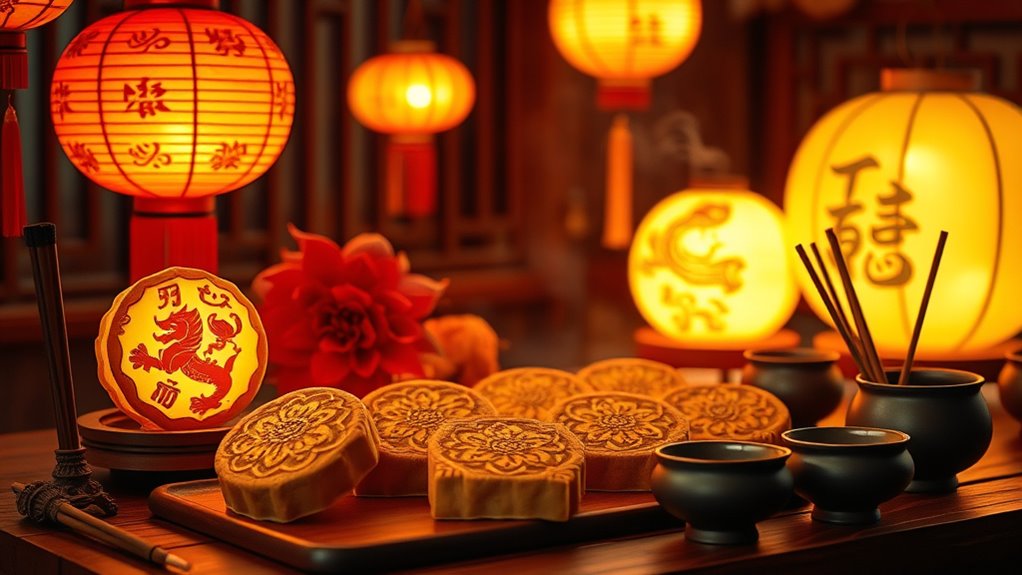
During the Mid-Autumn Festival, families engage in various rituals that honor lunar traditions and strengthen community bonds. You might set up outdoor altars, offering mooncakes, fruits, and flowers to the moon goddess Chang’e, seeking blessings for health and prosperity. In some places, moon worship remains a heartfelt practice, reflecting ancient agricultural customs. As evening falls, you’ll see colorful lanterns lighting up the streets—shaped like animals, flowers, or mythical figures—creating a festive atmosphere. Lantern parades often involve children and storytelling, with lantern riddles adding social fun. In southern regions, bonfires shaped like pagodas symbolize gratitude for the harvest. Meanwhile, in urban settings, you might notice street art celebrating the festival’s themes, blending tradition with modern creativity, and echoing the enduring spirit of Mid-Autumn rituals. Creating a warm farmhouse-inspired ambiance can enhance the cozy, communal feeling of the celebrations.
The Role of Family and Community in Festivities
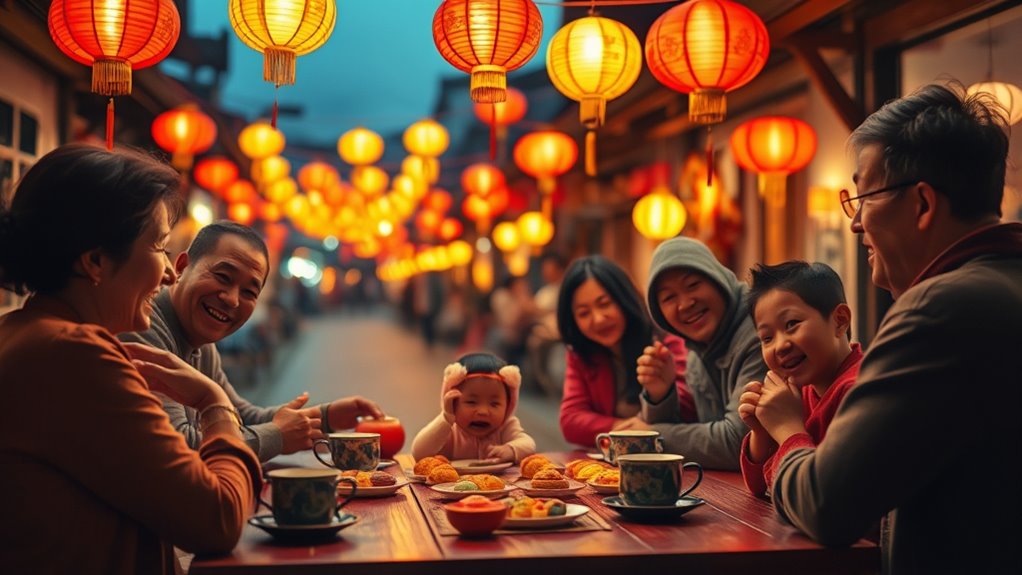
The Mid-Autumn Festival plays a pivotal role in strengthening family bonds and fostering community spirit. You gather with loved ones for reunion dinners, sharing special dishes like mooncakes and pomelos, which deepen family bonding. Many travel back to hometowns to be with relatives, creating shared memories and reinforcing kinship ties. Within families, preparing lanterns and food together symbolizes collective participation and unity. Outside, community celebrations like moon-gazing, lantern displays, and folk performances encourage social bonding among neighbors. These activities serve as opportunities to transmit cultural values across generations, while also celebrating harvest and prosperity. The use of traditional tableware during these festivities enhances the cultural significance of the celebrations. Whether through family gatherings or community events, the festival emphasizes harmony, gratitude, and the importance of togetherness, uniting people in a collective expression of cultural pride.
Modern Variations of Classic Festival Treats
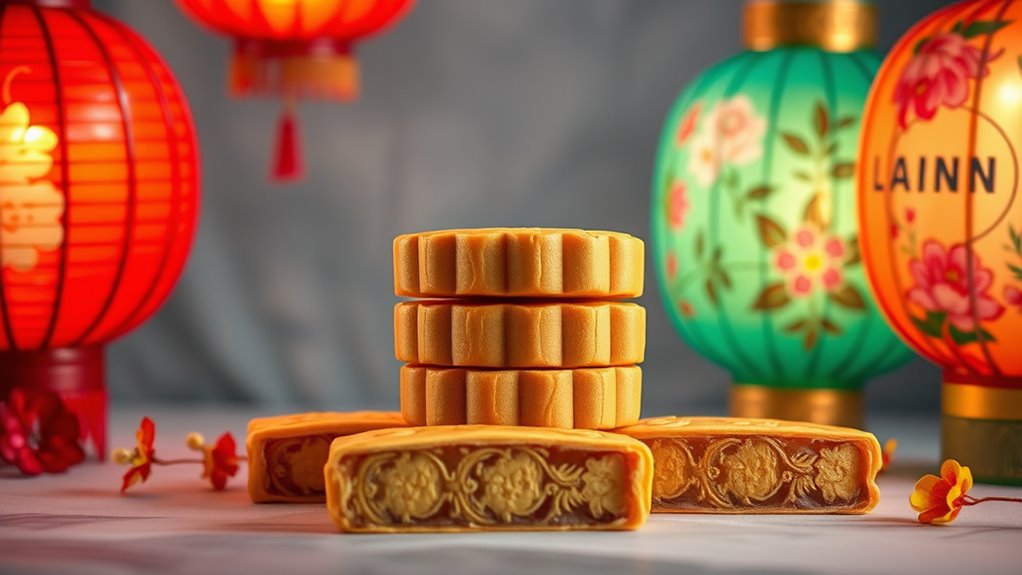
Modern twists on festival treats are transforming how people celebrate the Mid-Autumn Festival, blending innovation with tradition. You’re now seeing mooncakes with innovative flavours like Dubai Chocolate, red velvet avocado, mango pine nuts, and durian with salted egg yolk, appealing to diverse tastes. Snow skin variants and ice cream mooncakes offer invigorating alternatives, while jelly mooncakes suit hot climates. Artistic packaging elevates the gifting experience, featuring illuminated boxes with moon goddess silhouettes or collaborations with contemporary artists. These designs add cultural symbolism and modern flair, making mooncakes more than just treats—they’re collectible art. The focus on health-conscious options, like low-sugar or vegan varieties, caters to evolving consumer needs. Additionally, home organization techniques are being incorporated into packaging and presentation, creating a more memorable and stylish gifting experience. Overall, these modern variations make festival treats more exciting, personalized, and stylish.
Celebratory Customs and Their Cultural Roots

Celebratory customs of the Mid-Autumn Festival are deeply rooted in China’s rich history and reflect centuries of cultural significance. You participate in traditional rituals like moon worship, offering mooncakes, fruits, and incense to honor Chang’e and seek blessings. Family reunions are central, symbolized by the bright full moon representing unity and completeness. Community activities include lantern lighting, which symbolizes hope, and calligraphy art, often displayed during celebrations. Tea ceremonies are also common, emphasizing harmony and reflection. These customs originate from ancient agricultural rites and lunar worship, evolving into festive practices that emphasize gratitude, connection, and cultural heritage. Your involvement in these traditions keeps alive the historical roots of the festival, blending spiritual reverence with social celebration. Additionally, the symbolism of harvest underscores the festival’s connection to agricultural cycles and gratitude for a bountiful year.
Embracing the Festival’s Spirit in Contemporary Times
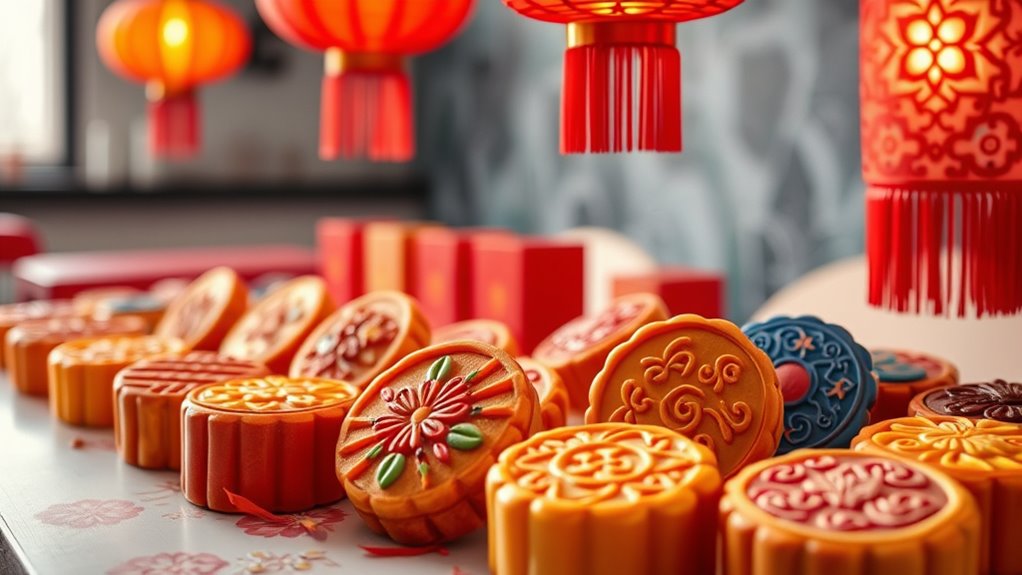
Changes in family structures and urban lifestyles have reshaped how you celebrate the Mid-Autumn Festival today. You might now enjoy festival moments with friends or alone, rather than traditional family gatherings. Technology plays a crucial role, with digital storytelling through live streaming, online mooncake tutorials, and virtual lantern displays expanding participation. Public festivals in cities showcase modern lantern designs and interactive events that attract diverse crowds. You’ll see:
Celebrating Mid-Autumn with digital lanterns, online stories, and eco-friendly mooncakes fosters community in urban life.
- Use of sustainable packaging for mooncakes and festival souvenirs
- Virtual lantern displays and online craft workshops
- Social media campaigns sharing contemporary festival stories
- Public night tours and cultural exhibitions blending tradition with innovation
- The adoption of Self Watering Plant Pots in urban gardening projects, reflecting a shift toward more sustainable and low-maintenance practices that align with eco-conscious festival themes.
These adaptations foster a sense of community and cultural identity, even amid individualism and urbanization. The festival’s spirit now thrives through new media and eco-conscious practices.
Frequently Asked Questions
How Have Mooncake Recipes Changed Over Centuries?
You’ll notice that mooncake recipes have evolved considerably over centuries. Traditional fillings like nuts, seeds, lotus paste, and salted egg yolks set the foundation, representing cultural symbolism. Today, chefs add modern twists with new ingredients, including red bean, jujube, chocolate, and even ice cream. This blend of tradition and innovation allows you to enjoy classic flavors while exploring exciting, contemporary variations that appeal to diverse tastes worldwide.
What Are Some Unique Lantern Designs From Different Regions?
Imagine walking through a night sky filled with glowing stories; that’s what regional lantern designs offer. In southern China, you see illuminated sculptures of rabbits, dragons, and phoenixes, with pomelo peel lanterns adding a traditional touch. Northern regions favor round paper lanterns shaped like peaches or animals, while Vietnam’s vibrant parades showcase colorful lanterns and masks. Each region’s unique craftsmanship turns light into a poetic expression of culture and hope.
How Do Rural Communities Celebrate Mid-Autumn Differently?
You see that rural communities celebrate Mid-Autumn differently through traditional customs like countryside moon viewing and family reunions. They set up outdoor altars with offerings, burn incense, and perform rituals honoring the Moon Goddess for blessings and harvest success. Children carry lanterns in processions, sometimes wearing pomelo rind hats, to symbolize guidance. These rural festival customs emphasize community, gratitude, and agricultural prosperity, making the celebration deeply rooted in local traditions and folklore.
Are There Specific Rituals for Moon Worship Today?
You’ll find that today, moon worship involves various moon rituals like offering incense, fruits, and mooncakes at altars or outdoors under the full moon. People also light lanterns, engage in prayer, meditation, and moon gazing ceremonies, symbolizing unity and harmony. Many incorporate modern practices such as setting intentions with lunar cycles, using tarot or crystals, and participating in silent retreats, blending ancient traditions with contemporary spiritual approaches.
How Is the Festival Celebrated Outside China?
Imagine a tapestry of vibrant lights and joyful gatherings—this is how the festival unfolds outside China. You’ll find urban celebrations brimming with lantern parades, mooncake tastings, and cultural performances, blending traditional customs with local flavors. International adaptations bring communities together, celebrating harmony and harvest. Whether in the U.S., Malaysia, or Kenya, you experience a fusion of heritage and modernity, making the Mid-Autumn Festival a truly global celebration of unity under the moon.
Conclusion
As you celebrate the Mid-Autumn Festival, you’re part of a timeless tradition that honors family, community, and cultural heritage. From mooncakes to lanterns, each element carries deep meaning and history. Will you embrace these customs and pass them on, or let their stories fade? By honoring the festival’s rich roots, you keep its spirit alive, connecting past and present in a celebration that truly illuminates the heart of your culture.
